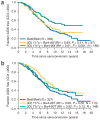Innate partnership of HLA-B and KIR3DL1 subtypes against HIV-1
- PMID: 17496894
- PMCID: PMC4135476
- DOI: 10.1038/ng2035
Innate partnership of HLA-B and KIR3DL1 subtypes against HIV-1
Abstract
Allotypes of the natural killer (NK) cell receptor KIR3DL1 vary in both NK cell expression patterns and inhibitory capacity upon binding to their ligands, HLA-B Bw4 molecules, present on target cells. Using a sample size of over 1,500 human immunodeficiency virus (HIV)+ individuals, we show that various distinct allelic combinations of the KIR3DL1 and HLA-B loci significantly and strongly influence both AIDS progression and plasma HIV RNA abundance in a consistent manner. These genetic data correlate very well with previously defined functional differences that distinguish KIR3DL1 allotypes. The various epistatic effects observed here for common, distinct KIR3DL1 and HLA-B Bw4 combinations are unprecedented with regard to any pair of genetic loci in human disease, and indicate that NK cells may have a critical role in the natural history of HIV infection.
Conflict of interest statement
The authors declare no competing financial interests.
Figures





Comment in
-
'Unleashed' natural killers hinder HIV.Nat Genet. 2007 Jun;39(6):708-10. doi: 10.1038/ng0607-708. Nat Genet. 2007. PMID: 17534364 No abstract available.
References
-
- Biron CA, Nguyen KB, Pien GC, Cousens LP, Salazar-Mather TP. Natural killer cells in antiviral defense: function and regulation by innate cytokines. Annu Rev Immunol. 1999;17:189–220. - PubMed
-
- Lanier LL. NK cell recognition. Annu Rev Immunol. 2005;23:225–274. - PubMed
-
- Colucci F, Di Santo JP, Leibson PJ. Natural killer cell activation in mice and men: different triggers for similar weapons? Nat Immunol. 2002;3:807–813. - PubMed
-
- Vilches C, Parham P. KIR: diverse, rapidly evolving receptors of innate and adaptive immunity. Annu Rev Immunol. 2002;20:217–251. - PubMed
-
- Gumperz JE, et al. Conserved and variable residues within the Bw4 motif of HLA-B make separable contributions to recognition by the NKB1 killer cell-inhibitory receptor. J Immunol. 1997;158:5237–5241. - PubMed
Publication types
MeSH terms
Substances
Grants and funding
LinkOut - more resources
Full Text Sources
Other Literature Sources
Medical
Research Materials

